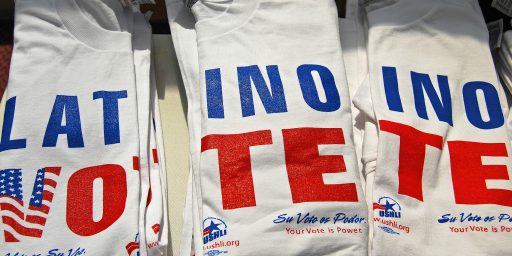The Latino Vote in Perspective
Though I myself have closely examined this bloc, I think that context is in order. Perhaps unsurprisingly, I’m prompted to move in such a direction because of a New York Times article [RSS]:
The Spanish-language television advertisements for President Bush went negative this fall, attacking Senator John Kerry’s voting record and his stance on abortion. Mr. Kerry’s Spanish television advertisements, in keeping with the traditional appeals that Democrats have made to Hispanic voters for generations, mostly stayed positive, rarely even mentioning Mr. Bush’s name.
But in the end, Mr. Bush won 44 percent of the Hispanic vote, more than any Republican presidential candidate in at least three decades. That tally, more than 10 percentage points higher than he received in 2000, shattered the Democrats’ hopes that a growing Hispanic population would help Mr. Kerry in Colorado or New Mexico, or perhaps even Florida.
Few experts say they believe Mr. Bush has achieved a seismic shift of the sort that Ronald Reagan brought about in the early 1980’s in winning over blue-collar white voters. A clear majority of Hispanics, after all, still voted for Mr. Kerry.
What is unquestionably clear, those experts say, is that like the great Latino wave in pop culture, which has more and more influence in areas like music, food and fashion, this election has taken Hispanic voters a giant leap away from being thought of as separate and different. A reliable Democrat no longer, taken for granted no longer – and more electable than ever in their own right, with the first two Hispanic United States senators in 30 years poised to take office, from Colorado and Florida – a new swing voter may have emerged.
“The bottom line to me is that with this result, it’s no longer sensible to think of Hispanic voters on a national basis as a core constituency of the Democratic Party,” said Roberto Suro, the director of the Pew Hispanic Center, a nonpartisan research organization based in Washington.
“We are up for grabs,” said F. Chris Garcia, a professor of political science at the University of New Mexico. “That is a good thing for Hispanics; we’re going to be more influential in the future and a bigger target for both campaigns.”
It is, of course, beneficial for Latinos to become more politically independent than, say, blacks: it will propel Republicans to court them aggressively and force Democrats to heed their interests. But let’s remember that Latinos made up 8% of the 2004 electorate, and in general, they account for around 5% of registered voters. Both figures are lower than their 13.3% share of the total population. I don’t mean to downplay Bush’s gains or Latinos’ potential; to the contrary, I think that both are significant. But we should remember that there’s still a lot of mobilizing to do — both in the parties’ and the ethnic leaders’ ends — and the Times ought to provide such perspective.
On the other hand, this observation is particularly insightful:
But the two parties’ different strategies, reflected in the Spanish television advertisements, Hispanic scholars and political analysts say, were revealing if not decisive. The Bush campaign approached Hispanic voters exactly the way it did everybody else: by reaching out for cultural conservatives, who in this case just happened to be Hispanic. The Kerry campaign sought votes as if Hispanics, as in the past, were reliably Democrat. The advertisements emphasized issues like immigration and economic opportunity and used few attack advertisement techniques, omnipresent on English-language television, to close the deal.
“The Democrats made a broad appeal to a Democratic base and not a specific appeal at all to religious Hispanic voters, or even specific segments of the Hispanic electorate,” said Adam Segal, director of the Hispanic Voter Project at the Johns Hopkins University. “The Bush campaign used moral values, and specifically the national discussion over gay marriage and abortion rights, as wedge issues within the Hispanic community to try to break off a conservative religious segment.”
The highlighted sentences reflect poorly on how attuned the Democrats are to the needs of the group. But, at the same time, Republicans must be careful of overreaching or jumping to conclusions. It’d be foolish, I think, to assume that Latino interests can always be conveniently met by making broad-stroke appeals. Fact is, there will be times when party strategists must tailor their message to the specific bloc — when simple proclamations of “We are all just Americans” may not resonate as strongly as we would want, despite demographic trends suggesting Latino assimilation. Political actors need to be practical and flexible in their approach. Otherwise, they risk losing support.




Fact is, there will be times when party strategists must tailor their message to the specific bloc…
James, I remind you of this passage from the last excerpt:
The Bush campaign approached Hispanic voters exactly the way it did everybody else: by reaching out for cultural conservatives, who in this case just happened to be Hispanic.
The campaign wasn’t reaching out to a Hispanic “bloc,” they were reaching out to conservatives. In short, they were “tailoring their message” as you say they must.